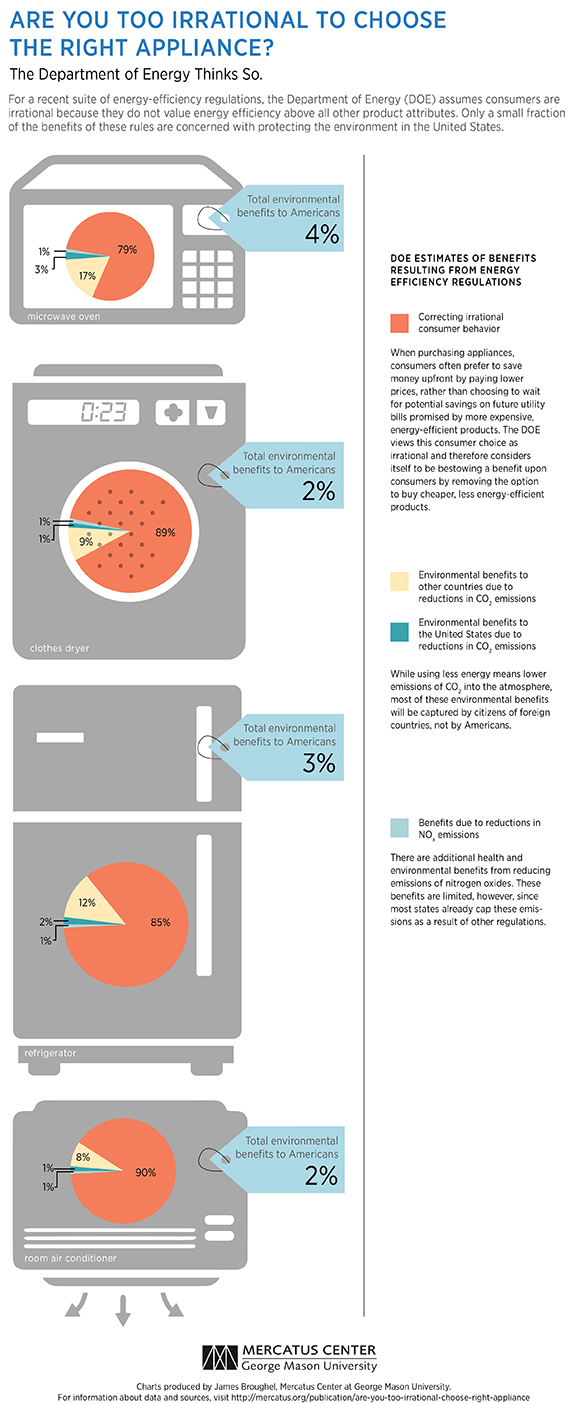- | Regulation Regulation
- | Data Visualizations Data Visualizations
- |
Are You Too Irrational to Choose the Right Appliance?
The Department of Energy Thinks So
New energy-efficiency regulations are sold to the public as a benefit to the environment. Regulatory agencies’ own estimates, however, demonstrate that the environmental benefits are only a fraction of the total benefits of these rules and are often exceeded by the societal costs they impose. These costs are passed on to consumers in the form of higher prices on everyday appliances such as microwave ovens, clothes dryers, refrigerators, and room air conditioners.
New energy-efficiency regulations are sold to the public as a benefit to the environment. Regulatory agencies’ own estimates, however, demonstrate that the environmental benefits are only a fraction of the total benefits of these rules and are often exceeded by the societal costs they impose. These costs are passed on to consumers in the form of higher prices on everyday appliances such as microwave ovens, clothes dryers, refrigerators, and room air conditioners.
Moreover, the expected environmental benefits from these rules include projected benefits to foreigners, with US citizens being the recipients of a small fraction of these total benefits.
If the environmental benefits to the United States are so small, how do agencies justify their rules? Regulators believe that consumers make irrational choices when purchasing appliances because they often choose to forgo lower energy bills in the future to pay a low purchase price for an appliance upfront. By forcing consumers to buy higher-end appliances they wouldn’t otherwise buy, regulators believe that they are conferring a benefit by protecting consumers from their own irrational choices.
Justifying regulations based on the premise that consumers are irrational is a dangerous precedent. It sets up government agencies to regulate based not just on market failure but also on personal failure.
Sources:
Department of Energy, “Technical Support Document for Energy Conservation Standards for Residential Refrigerators, Refrigerator-Freezers, and Freezers” (Table 1.2.1), August 2011.
Department of Energy, “Technical Support Document: Energy Efficiency Program For Consumer Products and Commercial and Industrial Equipment: Residential Microwave Ovens – Stand-By Power” (Table 1.2.1), May 2013.
Department of Energy, “Technical Support Document: Energy Efficiency Program For Consumer Products and Commercial and Industrial Equipment: Residential Clothes Dryers and Room Air Conditioners” (Table 1.2.1 and Table 1.2.2), April 2011.
Data Notes:
All benefits calculated using a 3 percent discount rate and the Department of Energy’s primary estimate of the Social Cost of Carbon (SCC). For the refrigerator, room air conditioner, and clothes dryer regulations, the SCC value is $22.1/ton (2009$ in 2010) of CO2. For the microwave regulation, the SCC value is $41.1/ton (2011$ in 2016) of CO2. Assumes 15 percent of reductions in CO2 emissions are attributed to the United States. This is the midpoint between 7 percent and 23 percent, the range estimated by the Interagency Working Group on Social Cost of Carbon, “Technical Support Document, Social Cost of Carbon for Regulatory Impact Analysis under Executive Order 12866,” February 2010.


